9 Angling and Conservation of Living Fishy Dinosaurs
Learning Objectives
- Explain the ancestral origins of primitive bony fishes of North America.
- Describe the major threats to Alligator Gar populations.
- Apply life history theory to explain the vulnerability of Alligator Gar to human activities.
- Describe habitat changes that strongly influence recruitment in Alligator Gar.
- Apply the concept of the values-beliefs-norms-actions causal chain to changes in human perceptions of gars.
8.1 The Primitive Bony Fish of North America
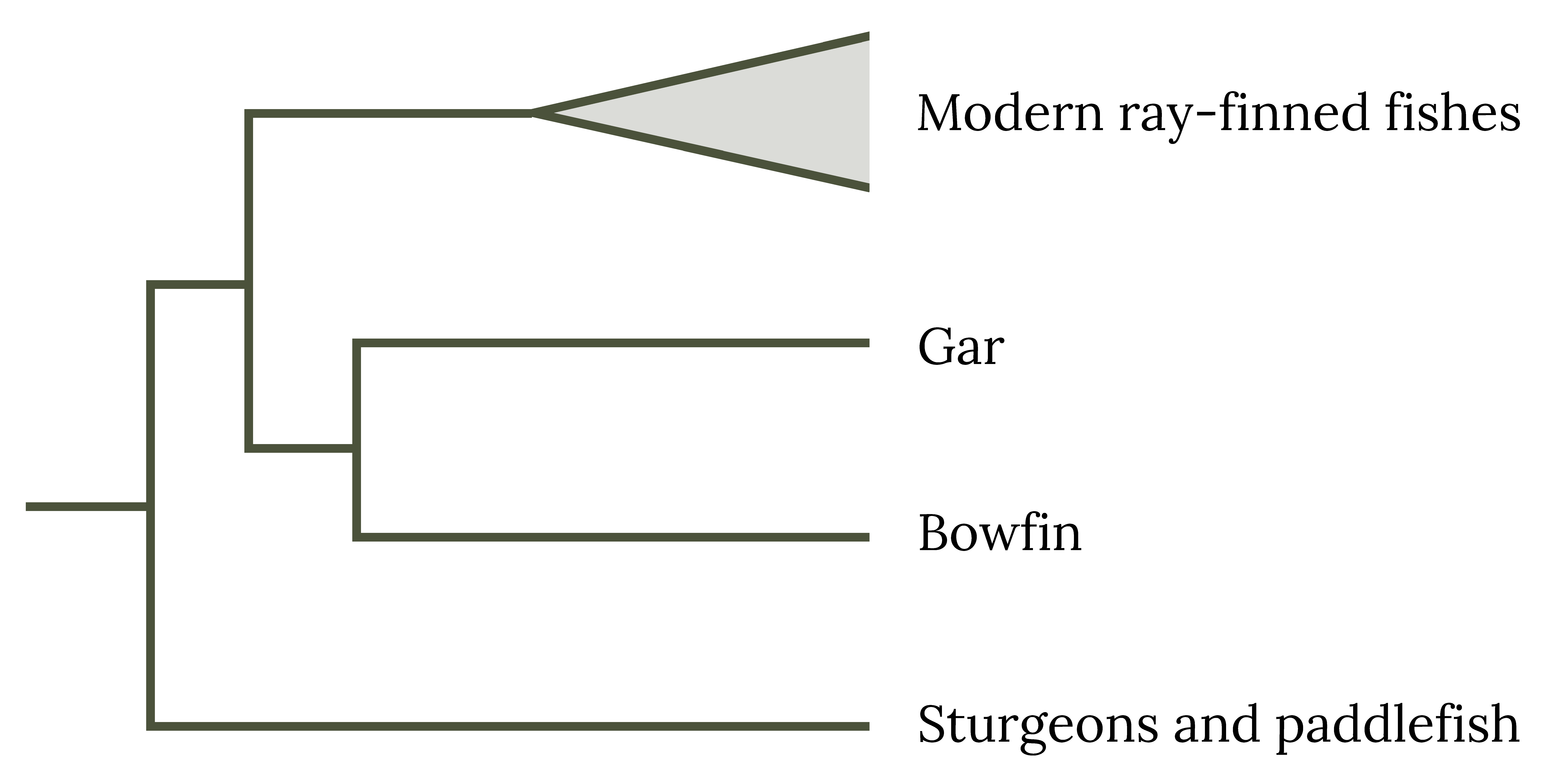
When the first flowering plants appeared on Earth and dinosaurs were the dominant large land animals, the ancestors of gars, bowfins, sturgeons, and paddlefish swam the waters of the ancient Tethys Sea. Hence, these primitive bony fish are often referred to as fishy dinosaurs. Paddlefish and sturgeon appeared in the fossil record 245 to 208 million years ago (Mya) near the end of the Triassic, making them among the most ancient of still-living ray-finned (actinopterygian) fish (Figure 8.1). These primitive fish groups survived the last major extinction on Earth (66 million years ago) and persisted throughout the second age of radiation of bony fish. With such a long history on Earth, one would assume that these fish are extinction proof. However, most populations of sturgeons and paddlefish are at risk of extinction (Boreman 1997; Pikitch et al. 2005), and the Chinese Paddlefish was recently declared extinct (Zhang et al. 2020). Overharvest and habitat change have influenced these primitive bony fish, and the success of conservation efforts depends, in part, on changes in human attitudes that will stimulate conservation actions.
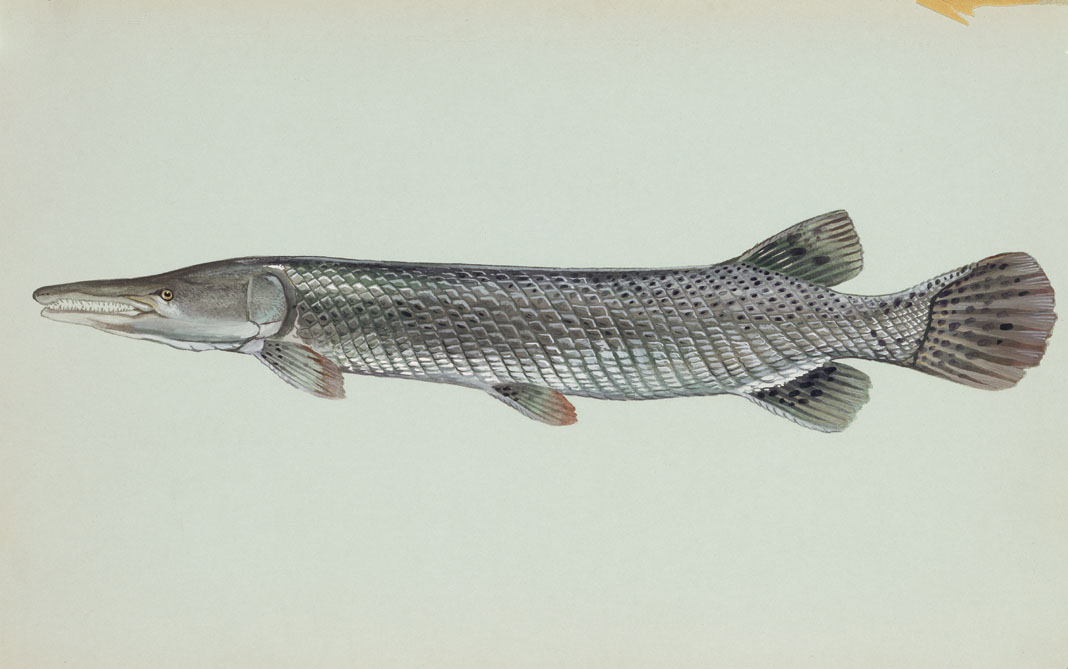
Sturgeon and paddlefish are vulnerable to impacts from human activities, in particular fisheries. Paddlefish and sturgeons display strong spawning site fidelity, and large shoals of adults gather over clean gravel-cobble stream substrates for spawning. Females have late maturity and do not breed each year. Even though a large female may produce a million or more eggs, these big, old, fat, fecund, female fish (BOFFFF) are very rare in exploited populations. The North American Sturgeon and Paddlefish Society (NASPS), the North American affiliate of the World Sturgeon Conservation Society, is dedicated to promoting the conservation and restoration of sturgeon species in North America by developing and advancing research pertaining to their biology, management, and utilization (Bruch et al. 2016). Efforts to restore Lake Sturgeon in the Winnebago System has resulted in opening of a well-regulated winter spearing season (Bruch et al. 2007). Similarly, recreational harvest is permitted for the American Paddlefish (Polyodon spathula) in certain Oklahoma waters (Cha and Melstrom 2018) and White Sturgeon in the Columbia River (Beamesderfer et al. 1995).
Unlike the sturgeons and paddlefish, gars and Bowfins are among North America’s most disliked fish, largely because of concerns that they eat game fish. The gar (family Lepisosteidae) have been around since the Jurassic and Cretaceous Periods (~150 to 160 million years ago), long before game fish of today emerged. Gars and Bowfins are the sister group (i.e., the closest relatives) to other teleost fish (Figure 8.1) and, therefore, of interest to evolutionary biologists. The largest gars are in the genus Atractosteus — the three extant species are Alligator Gar (A. spatula or Catan in Mexico), the Cuban Gar (A. tristoechus) or Manjuari from western Cuba, and the Tropical Gar (A. tropicus) or Pejelagarto from southern Mexico and Central America. Among these three, the largest is the Alligator Gar, which is most imperiled (Figure 8.2).
Questions to ponder:
What types of fish were living on planet Earth in the age of dinosaurs (345 to 66 million years ago)? How did these fish survive and dinosaurs went extinct?
8.2 Life History of Gars
Gars have a long, flexible cylindrical body with a hard bony covering and pointed snout with many sharp teeth. This body form is extremely well adapted for a sit-and-wait, ambush predator and not for fast, sustained swimming. The hard bony protection provided by ganoid scales emerged at a time when very large toothy aquatic reptiles, the large pliosaurs and their relatives, were still around. This bony covering is extremely difficult to pierce, even with a sharp filet knife. Each ganoid scale is rhomboid in shape and has a dorsal peg that articulates with a ventral socket joint on the adjacent, dorsally placed scale. Ganoid scales have a bony basal layer, a layer of dentine, and an outer layer of ganoine (an inorganic bone salt). Ganoid scales in gars are tightly overlapping on all parts of the body, creating the diamond-shaped pattern and the rather inflexible body form. Ganoid scales can resist powerful bite forces of self-predation and attack by alligators (Sherman et al. 2017). This chapter focuses mostly on the largest of the seven species of gars, the Alligator Gar (Figure 8.2).
Populations of the gars in the genus Lepisosteus (Longnose Gar L. osseus, Shortnose Gar L. platostomus, Spotted Gar L. oculatus, and Florida Gar L. platyrhincus) remain stable throughout much of their North American ranges. Longnose Gar, Spotted Gar, and Shortnose Gar are easily distinguishable from other gars by snout length and pigment patterns (Orth 2015; David 2016). For example, the spots on the body of the Longnose Gar are smaller and generally less well developed than on Spotted Gar. The snout length of Longnose Gar is more than 13 times its narrowest width in specimens 50 mm long or larger (Figure 8.3). Juveniles have a shorter snout, which grows proportionally faster than the body.
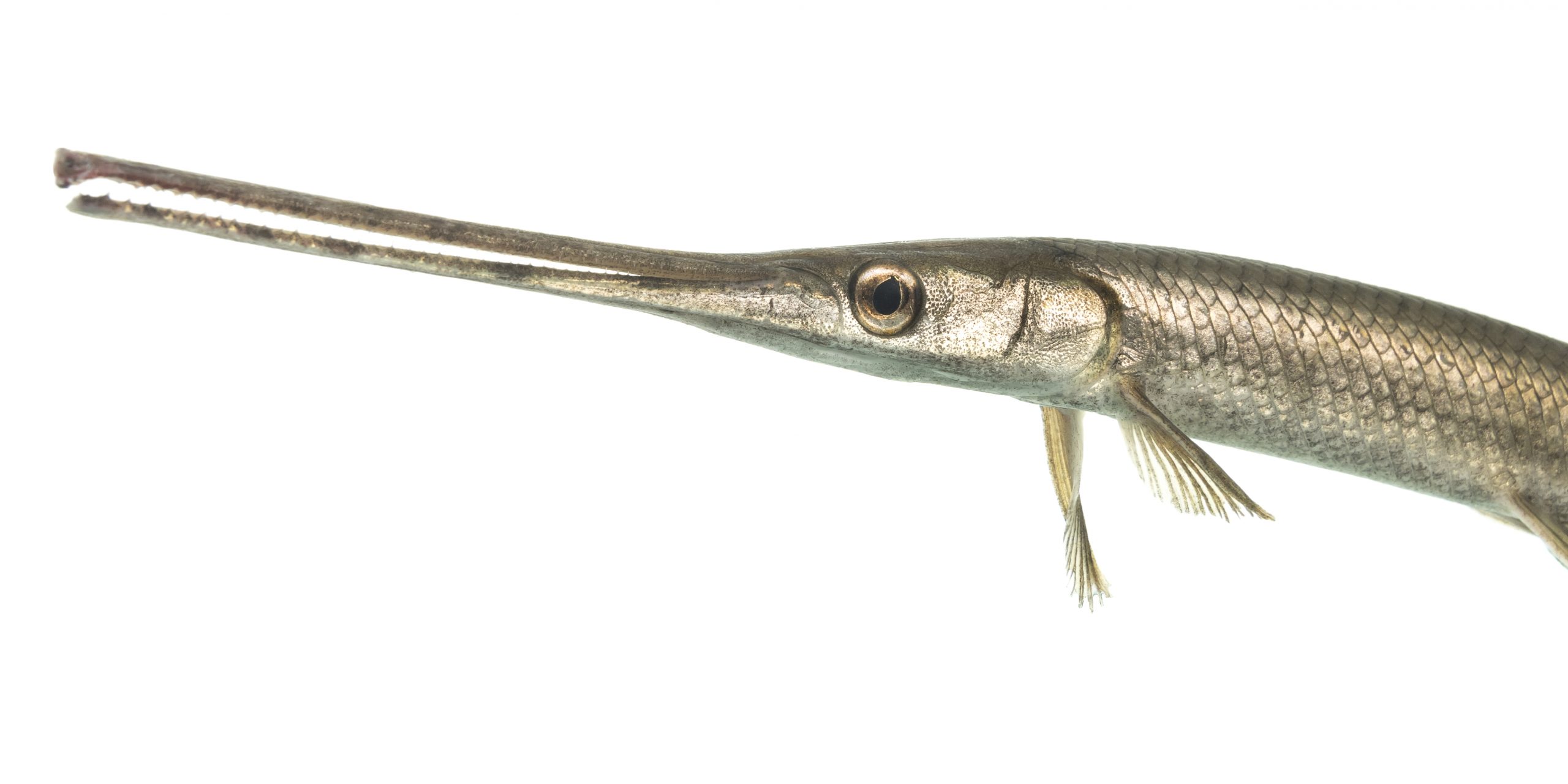
The Alligator Gar is rare, endangered, and has been extirpated from many outer areas of its range. Historically, the Alligator Gar’s home range included the Mississippi River and its tributaries from the lower reaches of the Ohio and the Missouri rivers southward to the Gulf of Mexico. Today, Alligator Gars are primarily restricted to coastal rivers, with inland populations persisting not only in Oklahoma but also in Florida, Georgia, Alabama, Tennessee, Arkansas, and Texas.
The unique life history of the Alligator Gar makes it very susceptible to overharvest and habitat change. Alligator Gars and other gar species have been commercially fished in southern states, and in recent years it has become a target of recreational hook-and-line anglers as well as bowfishers. The large size of the Alligator Gar and its numerous sharp teeth mean that it can produce a serious bite wound to those who attempt to handle it. There are no verified reports of attacks on humans. Eggs of all gars are poisonous to humans and other mammals, birds, and crayfish (Ostrand et al. 1996).
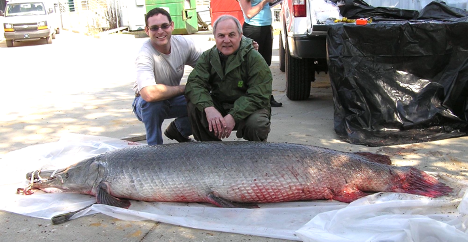
How large can they get? That’s hard to know because large specimens are no longer present in exploited populations. A commercial fisherman, while fishing for buffalo fish, caught a large Alligator Gar from Lake Chotard, Mississippi, on February 14, 2011. He had never seen an Alligator Gar that big—over twice his weight. The fish was barely alive after being tangled in the fisherman’s gill net. The fisherman barely had any freeboard after loading the big gar into his 16-foot boat. After calling a game warden, he found metal yard that had a big enough scale. The fish proved to be the largest Alligator Gar that’s ever been officially measured. It was 8.5 feet long, 47 inches in girth, and weighed 327 pounds (Figure 8.4). According to the International Game Fish Association (IGFA), the world record Alligator Gar captured by hook and line weighed 279 pounds. Larger Alligator Gar may be swimming in the wild, but the official measurements confirm that the Alligator Gar is the second-largest freshwater fish in North America (second only to the White Sturgeon).
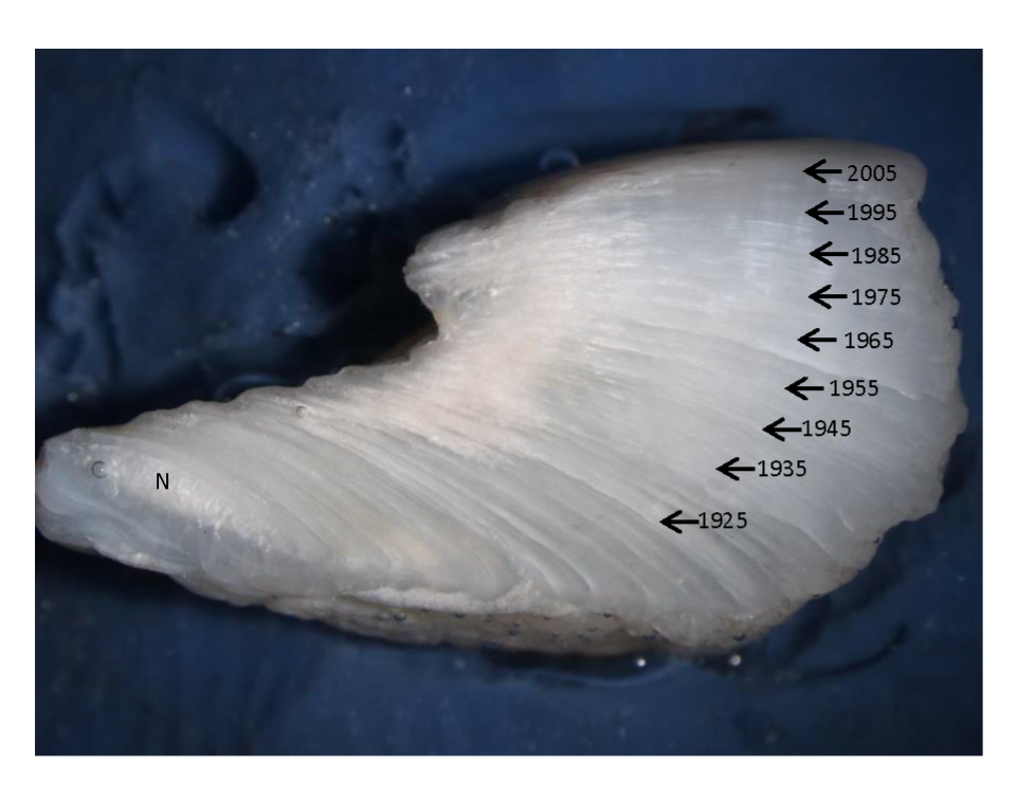
The Alligator Gar is a very long lived fish, although previous estimates of longevity have been underestimates. To accurately age an Alligator Gar, scientists must remove the inner ear bone (otolith), because other structures such as fin rays and scales provide underestimates of true age (Daugherty et al. 2020). The record 327-pound Alligator Gar was aged by scientists, who verified that the individual was 95 years old (Figure 8.5).
The Alligator Gar is typically a solitary fish that appears passive and barely moving while watching for potential prey. Gars may feed during the day or night and spend their time in a “lie-and-wait” position before ambushing. They are not fast swimmers, but prey capture involves a flex of their tail with mouth open to impale their target on the double row of super-sharp teeth. As adults they mostly feed on other fish but can consume waterfowl, turtles, mammals, and whatever’s most abundant.
What’s unique about the growth of Alligator Gars is their fast growth in the first years of life followed by slower growth (Figure 8.6; Figure 8.7). Juvenile Alligator Gars quickly transition to fish-eating habits (Butler et al. 2018). A fish diet means the juveniles grow at 4-5 mm per day in the first three months of life, so that by the end of the first growing season they may reach 1.5 to 2 feet in length (~40–70 cm) and 8–10 pounds in weight (Sakaris et al. 2019). Despite their fast growth, young Alligator Gars are preyed upon by many larger fish.
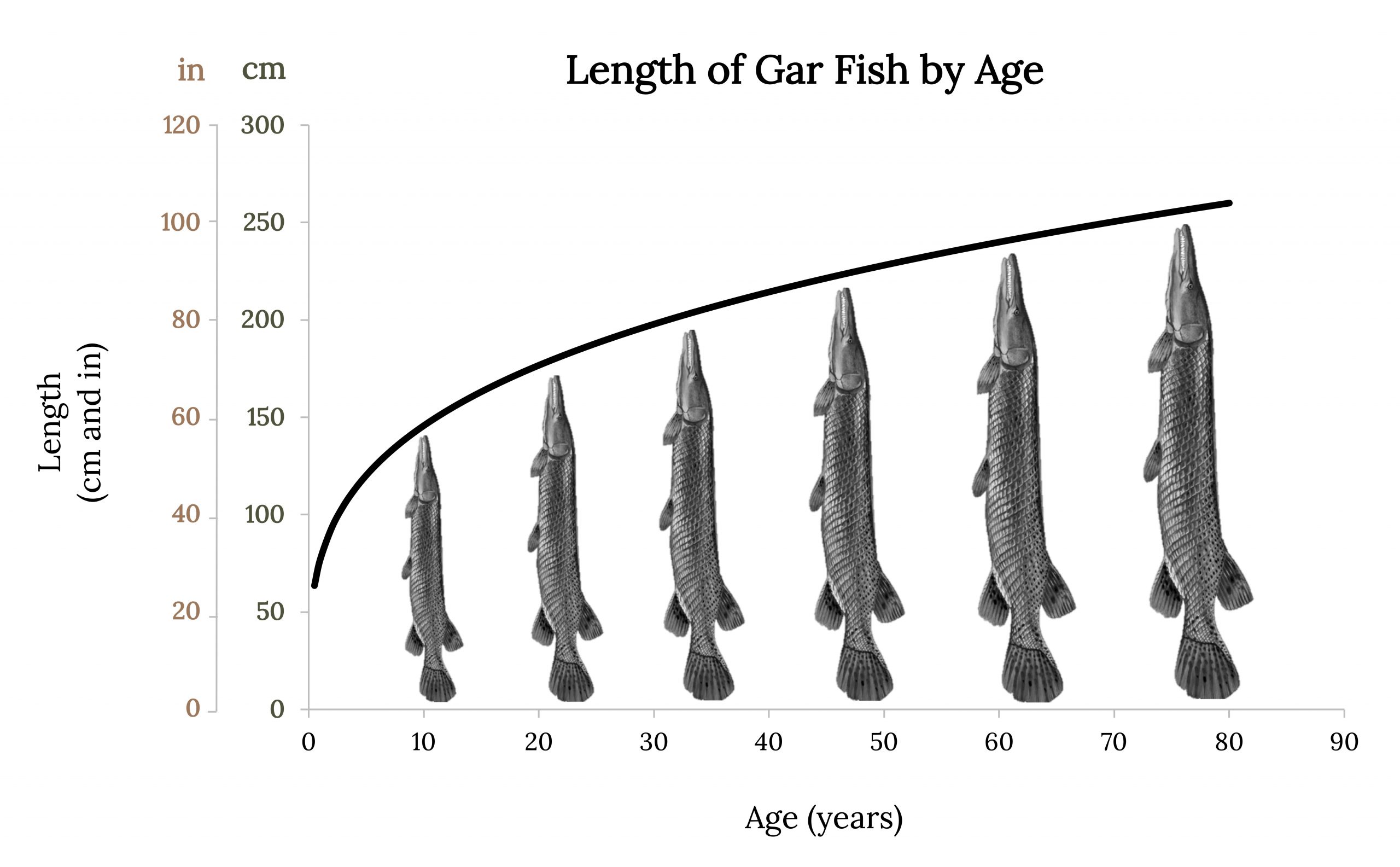
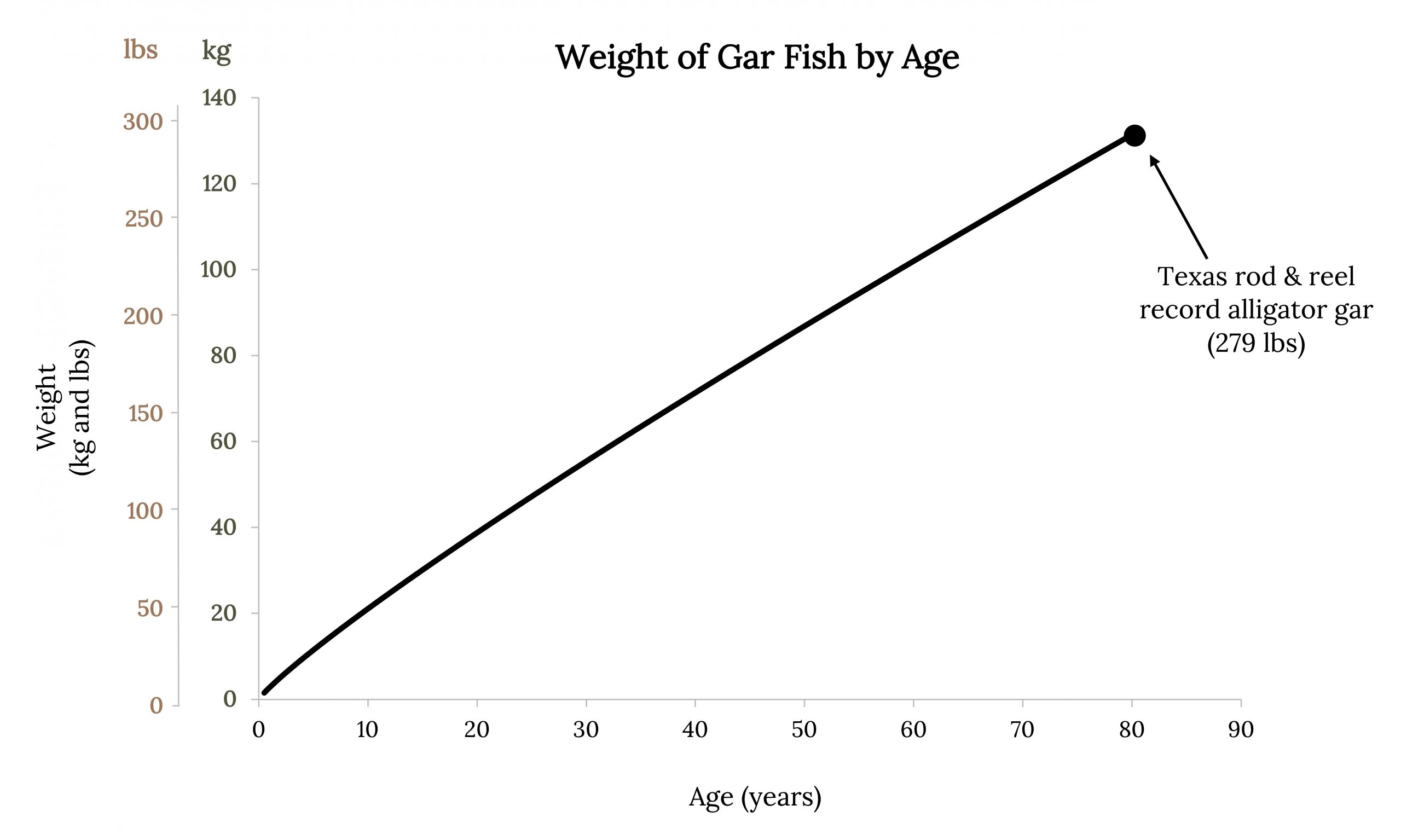
Addition of new individuals to a population depends on fish surviving to maturity, finding mates, and surviving and growing through many challenges in egg, larval, and juvenile stages. Although many eggs may be produced, survival to maturity is very low. In fact, recruitment failure is typical in Alligator Gar populations, with successful recruitment observed in only 3 of 10 years (Figure 8.8).
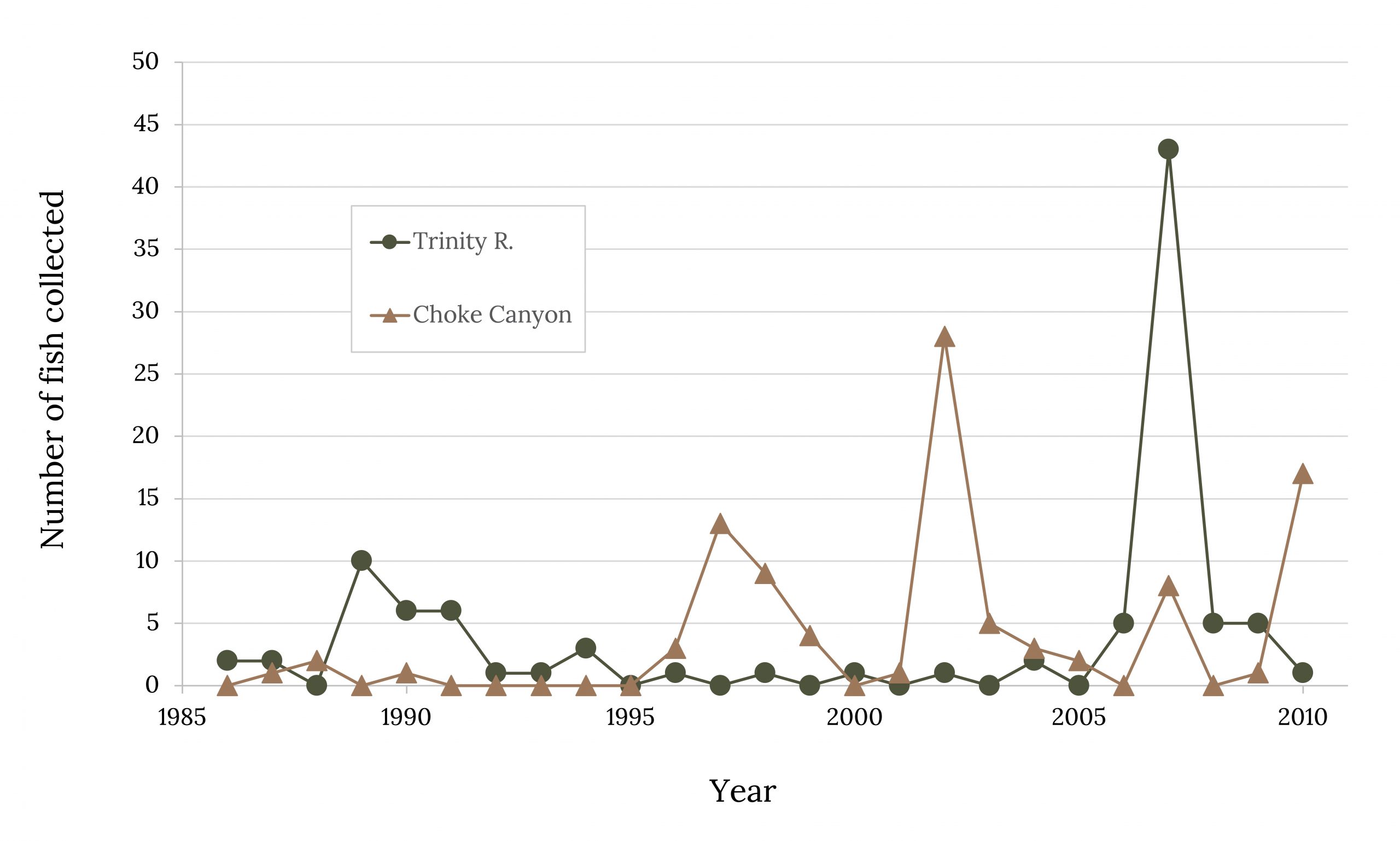
After the first year, very few predators threaten Alligator Gars. The only known predator is the American Alligator, and annual survival for adults may be as high as 91.5%. This means that only a few individuals in a population will survive to be trophy catch or BOFFFF, especially in populations that are heavily fished (Figure 8.9). BOFFFFs typically produce more and more viable eggs, are able to outlive unfavorable periods, and survive to spawn multiple times (Hixon et al. 2014). Unfortunately, in the case of Alligator Gars, the benefits are not fully realized because the large fish in the lower Trinity River, Texas, had high concentrations of mercury, polychlorinated biphenyls (PCBs), and organochlorine pesticides (Harried et al. 2020).
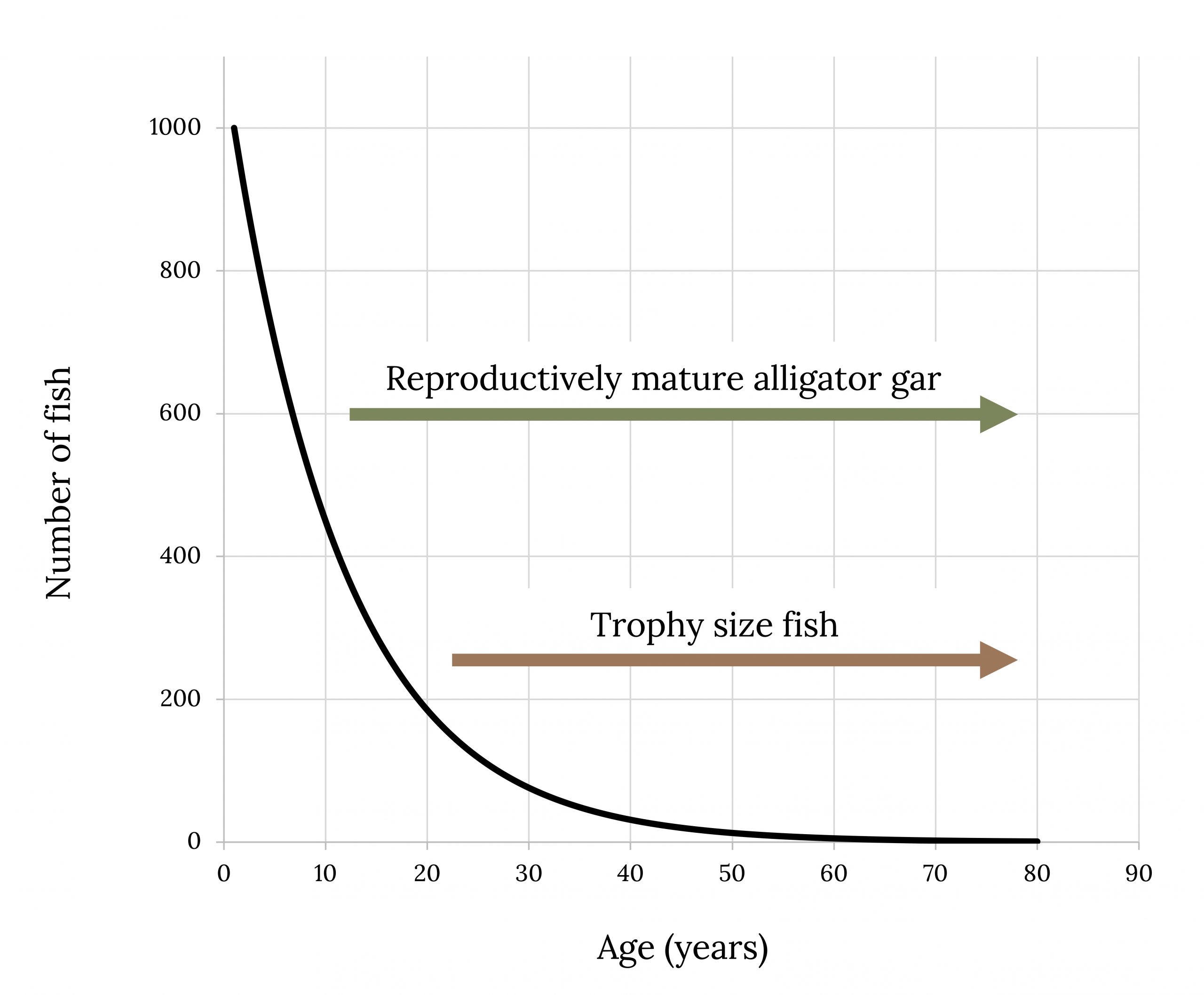
Long life, variable recruitment, and low juvenile survival lead to vulnerability to overfishing in Alligator Gars. Female Alligator Gars produce many small offspring, and tiny little eggs. Male Alligator Gars remain in shallow spawning areas longer, making them vulnerable to sight-fishing. And all those traits mean that these fish are vulnerable to overfishing without restrictions on daily harvest. Every loss of a mature Alligator Gar influences the total number of eggs that may be produced. The biggest gars are almost always female fish. The spawning potential ratio (SPR) measures the total output of eggs relative to that in an unfished population. SPR drops rapidly as the exploitation rate increases (Smith et al. 2018; Figure 8.10). Alligator Gar populations may be able to sustain annual harvests of only 5%. Thus, regulations in some trophy waters are set at only one fish per day bag limit (Binion et al. 2015; Buckmeier et al. 2016).
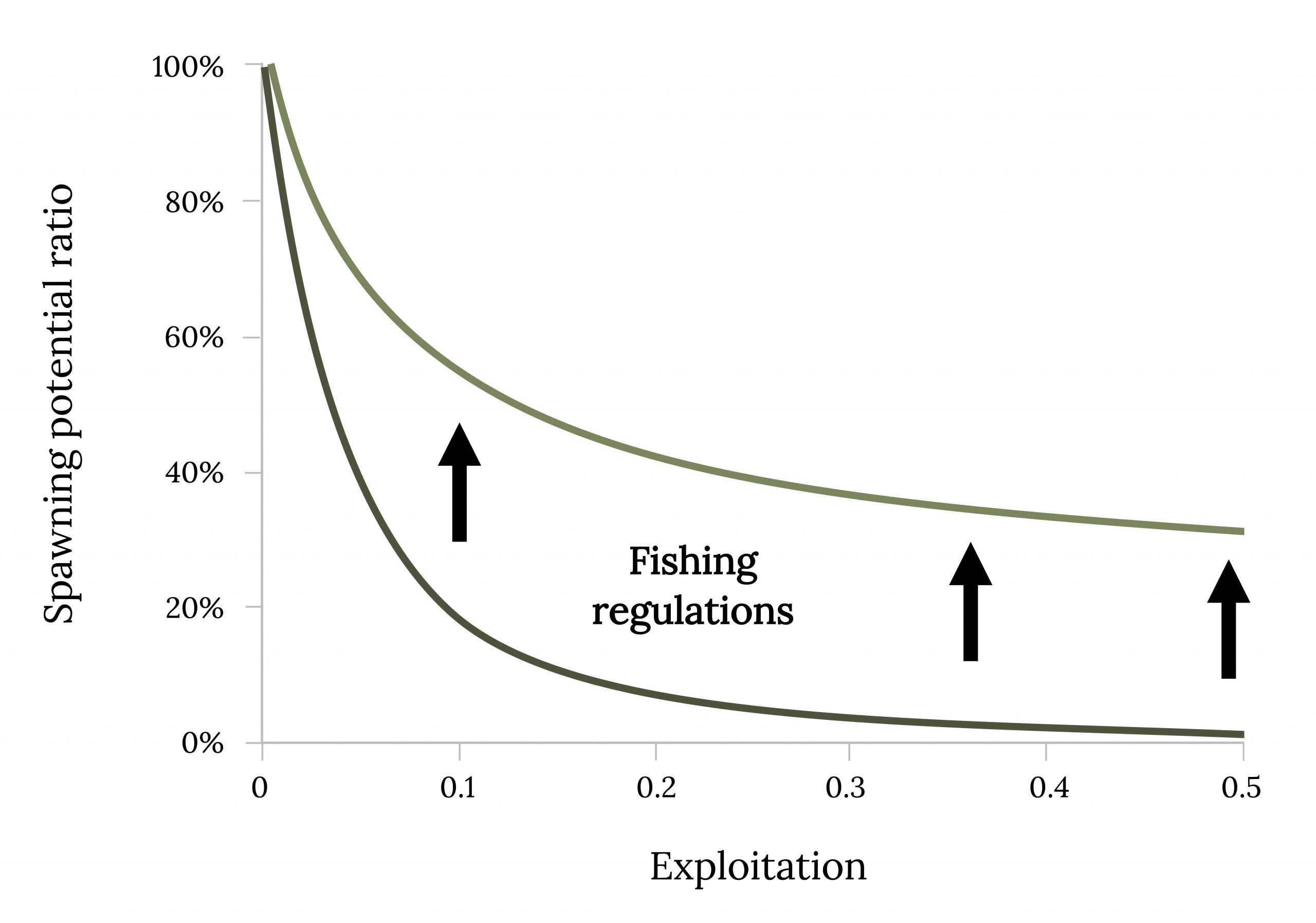
Question to ponder:
Describe aspects of the life history of Alligator Gar that makes them vulnerable to overfishing.
8.3 Mistreatment of Gars
Before European colonists came to North America, the gars were held in high status by indigenous peoples. Gars are still a popular food fish in various parts of Mexico and Cuba. In the southeast United States, indigenous people ate a variety of fish and mollusks, but gars were captured for food (Reitz et al. 2021). Native peoples did eat gar, and the scales were used to make arrow points, and the skins were used as breastplates. There is also evidence that ritual dances of Native American tribes were inspired by the gar.
European colonists did not give gars respect as a food fish or game fish. Instead, they were considered voracious pests based on misinformation. They were believed to be “responsible for the destruction of great numbers of useful and valuable fishes,” and that’s where the story of gar persecution begins (Caldwell 1913). The following quotes from so-called authorities at the time would eventually be proven incorrect:
- “Fishermen everywhere destroy it [the Longnose Gar] without mercy. Its flesh is rank and tough and unfit even for dogs” (Jordan 1905, page 30).
- “Certainly if our commercial fisheries are to be properly conserved, stringent measures will have to be taken against these ‘weeds’ and ‘wolves among fishes” (Richardson 1913, 407).
- Gars “are responsible for the destruction of great numbers of useful and valuable fishes” (Gowanloch 1933).
- “The time will doubtless come where thorough going measures will be taken to keep down to the lowest practicable limit the dogfish [bowfin] and the gars—as useless and destructive in our productive waters as wolves and foxes were in our pastures and poultry yards” (Forbes and Richardson 1920, 41).
- “First time I saw an alligator gar I damn near threw up. They ain’t natural anything get that big. It’s ten feet long and three feet at the girth. Not one of God’s creations like you and me. Some say they ain’t afraid of alligator gar fish. Bullshit. You look at that thing. It’s big and mean. Swallow both of us. Them people say they ain’t afraid tellin’ lies” (Bukka White, blues singer and guitarist).
- “Gars are highly predaceous animals, stealthy and persistent destroyers of a vast quantity of aquatic life” (Gowanloch 1940, 292).
The following poem was written by Missouri Assistant Attorney General Lovan, interpreting the state’s right to kill gars:
Mr. Deputy in charge of fish,
You are informed it is my wish,
That you take some dynamite in your flivver
And proceed to Jack’s Fork river,
And, standing on the gravelly bar
Cast in the shots to kill the gar.
But when you execute this command
Don’t forget the law will demand
That while killing a gar, you must not harass
A single sucker, catfish, or bass.
You must obey instructions without fail
Or run the risk of going to jail.
—State v. Freeland 1927, 627 (from Scarnecchia 1992)
Missouri Game and Fish and other agencies would target and kill large numbers of gars. In the April 1926 issue of Missouri Game and Fish News (Figure 8.11), we learn about law enforcement people in Missouri going out and destroying 5,000 gars because of the damage that they were believed to be causing. Many times, agencies directed efforts to exterminate gars, including the use of the Electrical Gar Destroyer deployed by the Texas Game Fish and Oyster Commission (Burr 1931). Up until recently, most states had no limits on harvesting gars.
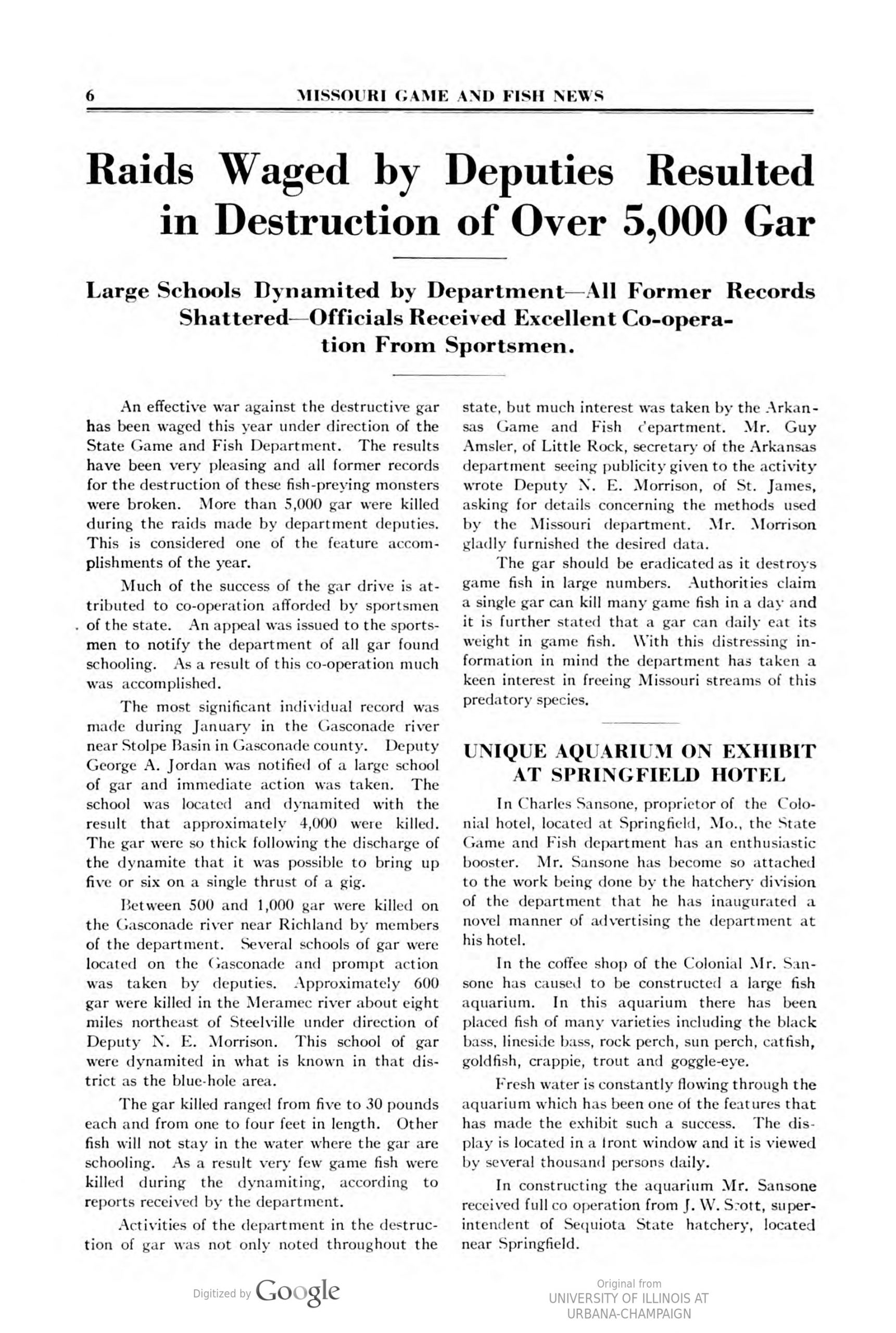
During most of the twentieth century, gars were viewed as harmful by most anglers and even fisheries managers. Yet, the Richardson (1913, 407) warning of the need for stringent measures against these “weeds” and “wolves” was based only on visual observations of adult Shortnose Gar (Lepisosteus platostomus) and not on any scientific evidence of harm.
Scarnecchia (1992) reported that even by the late 1980s, it was not legal to release gar alive in Iowa. Section 109.114 stated, “It shall be unlawful for any person to place any gar pike in any waters of the state, and such fish when taken shall be destroyed.” Tarzwell (1945) explored the possibility of commercial fishing for rough fish in Tennessee Valley Authority reservoirs. Too often the gars were simply thought of as a rough fish problem to be solved and not a resource to protect and conserve. Ironically, today fish markets of Arkansas cannot supply the demand for gar meat, which fetches a price higher than catfish fillets. Researchers investigating feeding habits of gar support the view that consumption of game fish is minimal.
Catching an Alligator Gar (often referred to as “gator gar”) is not so easy. They are not abundant today and occur in large floodplain rivers of the delta region of Louisiana, Arkansas, Mississippi, and Texas. It is very hard to impale the toothy jaws with a barbed hook. Most gars are caught by accident by commercial fisheries or targeted by bowfishers. Unfortunately, those who learn to catch gator gar with bowfishing, trot lines, and heavy-duty equipment often leave them dumped by the truckload or turned into fertilizer. Today, some anglers are “hooked” on targeting the monster gator gar, or le poisson armé (the armored fish), as the French explorers referred to it. When author Mark Spitzer (2010, 2015) hooked his second monster gar, it was just as Jack Harper described in Outdoor Life (1950): “They call him gar. His mother is a hurricane and his father is a ring-tailed tornado, and when he’s mad he’s one fish wave of destruction.”
Question to ponder:
Describe the causal chain of influence from values, beliefs, norms, and actions as it applies to early actions of European colonists toward gars. Contrast that with values, beliefs, norms, and actions of modern conservationists.
8.4 Bowfishing Controversies over Ethics and Waste
Bow anglers are a growing and dedicated constituency with specialized boats and equipment. Bowfishers in Texas represented only 3% of Texas freshwater anglers, were primarily male (97%), and fished 46 days per year, reporting a success rate of 57% (Bennett et al. 2015). Bowfishing may account for the majority of recreational harvest of Alligator Gar in Texas (Buckmeier 2008).
Bowfishing has grown in popularity, despite controversies over ethics and waste. Unlike hook-and-line fishing, bowfishing means that Alligator Gar are captured and killed. There is no such thing as catch and release. Wanton waste laws can be applied to all fish caught, requiring anglers to either release them or eat them. For example, Virginia’s Wanton Waste Law holds that “No person shall kill or cripple and knowingly allow any nonmigratory game bird or game animal to be wasted without making a reasonable effort to retrieve the animal and retain it in their possession” (4 VAC15-40-250 Wanton Waste Virginia Law).
Also, because many bowfishers stalk fish at night in order to get close, the notion of fair chase has been questioned. Fair chase is the ethical, sportsmanlike, and lawful pursuit and taking of any free-ranging wild, native North American big game animal in a manner that does not give the hunter an improper advantage over such animals. Many dislike the idea of bowfishing because modern equipment and practices do not permit fair chase.
In response to criticisms, the Colorado Bowfishing Association (COBF) developed a member code of ethics (see below).
It is our responsibility, as sportsmen and members of the COBF, to act in a responsible, professional, and ethical manner when engaging in the sport of bowfishing. Our individual actions, both good & bad, can have an enormous impact on the sport of bowfishing for current and future generations of sportsmen.
This code provides a clear standard of conduct for a bowfisher and gives the public a clear indication of what to expect from a COBF member.
- As a member of COBF, I will subscribe to a higher standard of ethical and sportsmanlike conduct.
- I will not breach, encourage or condone any violation of the Colorado Division of Wildlife’s fishing regulations or local lake regulations. I will always be in possession of a valid fishing license when engaging in the sport of bowfishing and will only pursue and harvest those species deemed legal by the Colorado Division of Wildlife for take with archery equipment.
- I will always engage with a safety first policy when bowfishing which includes inspecting my equipment—bowstring, arrows, nocks, tips, reel and line—for unsafe wear or damage; keeping my bow pointed in a safe direction and being sure of my target—what is in front of it, to the side of it and behind it.
- I will be aware of others around me. If other fishermen are nearby I will keep a safe, courteous distance and will share the waters with my fellow sportsmen.
- I will take the time to answer questions about the sport of bowfishing and always represent the COBF in a professional and courteous manner.
- I will make good use of the fish I harvest and will never leave my fish on the public shoreline or within communal trash receptacles. Doing so is not only unethical but tarnishes the sport of bowfishing for all. If I do not have a plan to make good use of the fish I am about to harvest, I should not be bowfishing.
- I will make my best attempt to rotate where I bowfish so to not over fish a body of water. I will do this to help manage Colorado’s fisheries and hopefully ensure the preservation of the sport of bowfishing for current and future generations.
Scarnecchia and Schooley (2020) reported that only nine states surveyed had bowfishing education programs and none had articulated bowfishing management goals. Management agencies can examine how many native fish are currently being managed or not managed. Native fish advocates maintain that certain fish—including Alligator Gar, Bigmouth Buffalo, and paddlefish—should not be permitted targets of bowfishing, just as bowfishers may not shoot trout, bass, and other “game” species. With growing interest in bowfishing, the controversies will continue.
Question to ponder:
In your opinion, what are some key characteristics of responsible, ethical fishing for Alligator Gar?
8.5 Habitat Connection
Gars are fascinating and misunderstood creatures, and unfortunately, the influence of habitat restoration for them has not yet been fully explored. Can we save one of the largest fish in North America with floodwaters? Rivers in the range of Alligator Gar are highly altered due to dams, dikes, dredging, and other forms of habitat and flow alteration. Managers need to understand what drives populations of Alligator Gar if the species has any chance to be restored throughout its range (Buckmeier et al. 2017). Recently, investigators confirmed suspicions that Alligator Gars are dependent on seasonal flooding in large floodplain rivers (Robertson et al. 2018).
Efforts are now underway to restore these magnificent creatures via supplemental stocking. It will take up to 50 years for stocked Alligator Gar to reach the potential maximum sizes. Stocking is an expensive short-term strategy, which may be necessary until natural spawning and rearing habitats can be restored. Although the effects of hydrologic modification of rivers is well documented, the prevailing questions related to reestablishing ecologically sustainable flows, such as “How much?” and “How often?” remain unanswered. Fully mature Alligator Gars may produce 200,000 or more large eggs (2–4 mm in diameter). These BOFFFF need to be protected from harvest, and we also need to provide habitat so that they will spawn naturally.
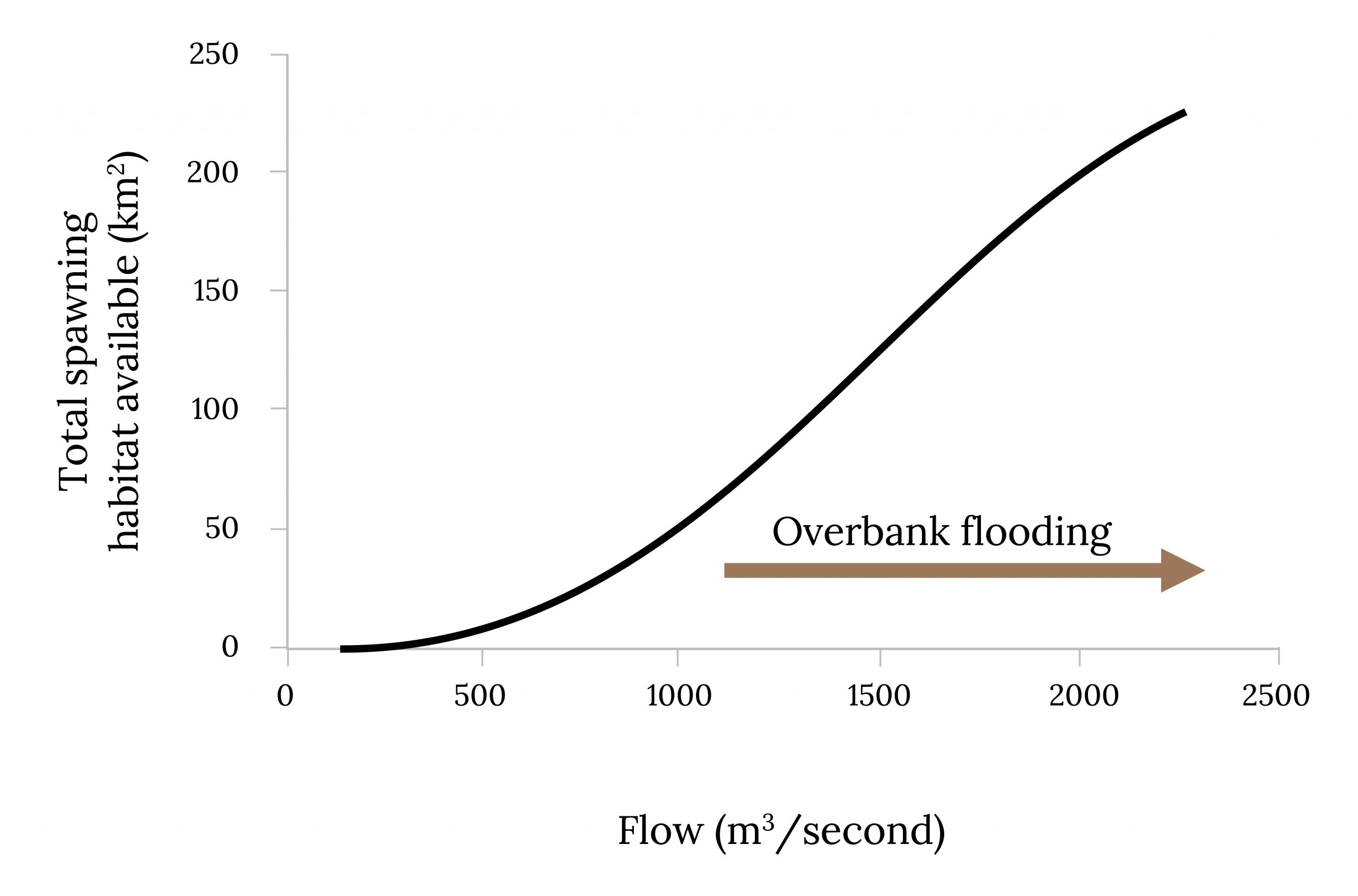
What is suitable habitat for spawning? The life history of Alligator Gar is tuned to life in large floodplain rivers where spawning is synchronized with the high flow-pulse events (Buckmeier et al. 2017). Alligator Gar spawning habitat includes floodwaters between 0.2 and 2 meters deep over woody vegetation and open-canopy vegetation types. Spawning habitat increases as the river flow increases enough to spill onto the floodplains (Figure 8.12; Robertson et al. 2018). However, Alligator Gars must be able to access these newly flooded habitats. Dams can block migrations of these fish as they seek spawning habitats (Lochmann et al. 2021).
Alligator Gar congregate in newly flooded backwaters (Kimmel et al. 2014) when water temperatures exceed 20°C (68°F). Fertilized eggs are deposited on woody debris and vegetation and will hatch in two to four days. The larvae of all species of gars have an attachment organ on the head (Figure 8.13) to allow larvae to attach to vegetation, as the yolk sac is used for energy. Eggs of gars are toxic to birds, mammals, and crustaceans, thereby reducing some predation. Rapid growth of larvae and juveniles will permit large numbers to survive if floodwaters occur at the right time and persist during this vulnerable period for young gars (Allen et al. 2020; Schumann et al. 2020).
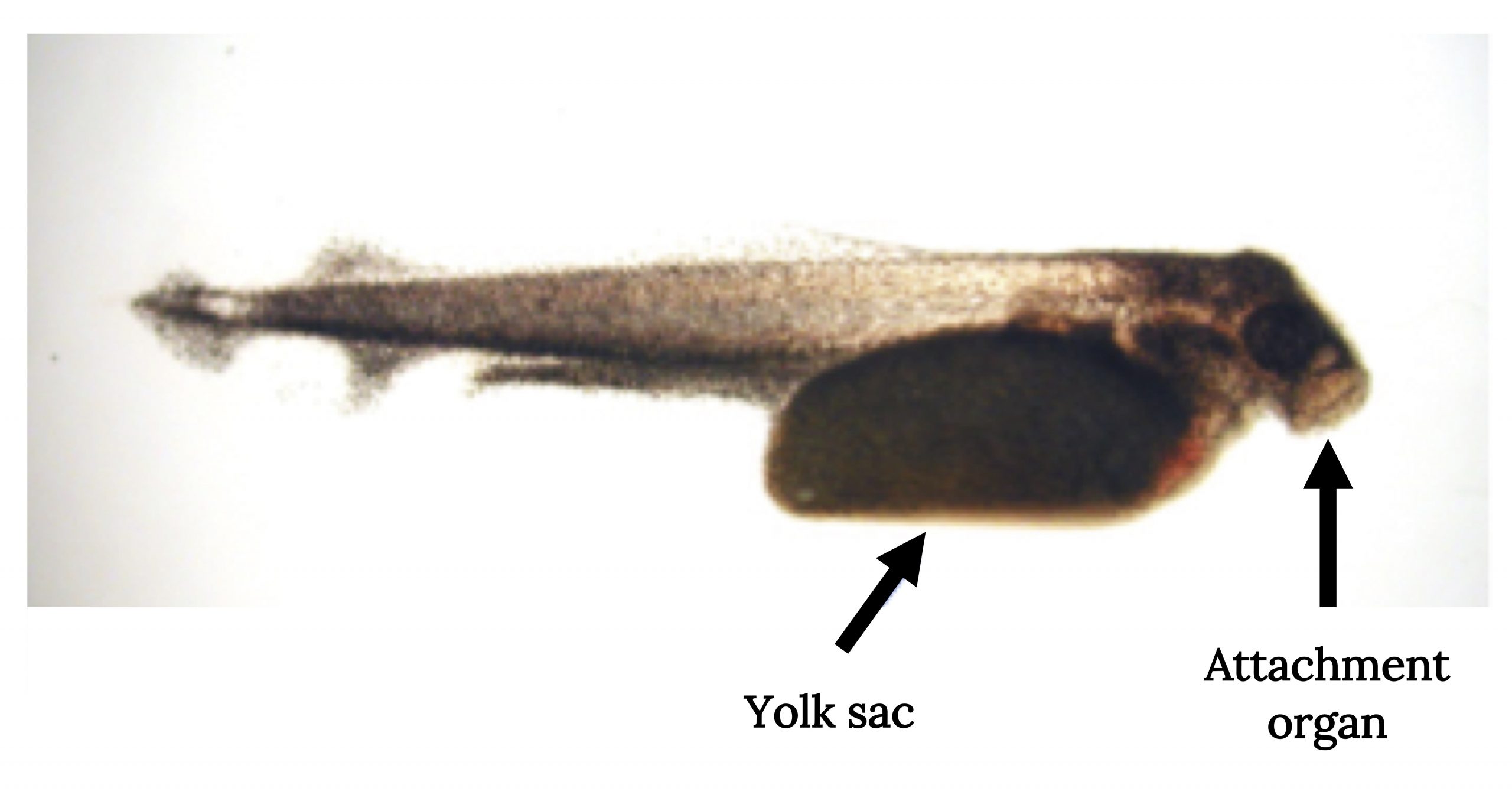
The lessons from the Trinity River study give us optimism for population restoration here and elsewhere. The demand for water from the Trinity River is growing from population centers of Dallas-Fort Worth and Houston, and flood-pulse management may provide for periodic strong Alligator Gar recruitment. While many are experimenting with spawning and stocking of Alligator Gar (Mendoza et al. 2008; Schmidt 2015; Frenette and Snow 2016; Snow et al. 2018; Porta et al. 2019; Long et al. 2020), the restoration of natural habitat when and where it is needed has the best likelihood for long-term sustainable populations. Therefore, we must maintain the periodicity of flood pulses that connect river channel habitats to backwater areas to ensure Alligator Gar recruitment. Maintenance of river flows will also be critical to the preservation of estuarine habitats used.
Alligator Gar habitat restoration is a “Field of Dreams” plan—If you build it, they will come. If we create large expanses of spawning habitat, breeding Alligator Gar may receive the cue to initiate the courtship and spawning behavior. However, if dam operations cut off the flood pulse after spawning, recruitment will be reduced. The longer duration of the flood pulse enhances nursery habitats for young Alligator Gar.
8.6 From Pest to the Target of Conservation
The history of fish management depicts eras of abundance and discovery, followed by exploitation, then protection and management, and eventually holistic environmental management. The changes in human attitudes are evident, as people shifted from viewing gars as pests to be destroyed to targets for ecosystem conservation. The values-beliefs-norms-actions causal chain explains human perceptions and actions relative to the gars. European colonists in North America had value orientations associated with dominion over living things. Many early fish biologists were misinformed about the role of gars and viewed them as indiscriminate predators who decimate the highly valued game fish. These early beliefs made the lack of control programs and fishing regulations for gar as norms and encouraged people to remove them (Scarnecchia 1992). Gars were considered undesirable “rough fish.”
“Rough fish” (or the slang, “trash fish”) is a term used in the United States to describe fish that are less desirable to sport anglers. Harriet Carlander, in History of Fish and Fishing, explained that the term “rough” was a term used for lower-valued fish that had only been partly processed during a busy day of fishing. These fish could not be sold for full price. In northern Europe, the term is “coarse fish.” Today, the term persists, but many types of rough fish (roughfish.com) are pursued by anglers interested in capturing the wide variety of species that exist in U.S. waters. The negative connotations of the term are unfortunate, and should be abandoned. Putting buffalo fish, carp, and gar in the same category for management makes no sense.
“What’s in a name? That which we call a rose, By any other name would smell as sweet.” Rough fish have value, and the terms we use should reflect that value. For example, the Common Carp and the four Asian carps all have demonstrated a high probability of causing ecological and economic effects where populations become established (Conover et al. 2007). Regulations on bowfishing should be liberal to encourage the take of these species so that they are turned into food or fertilizer. Bowfishing tournaments have partnered with organic fertilizer companies to utilize the harvest. Carpbusters Inc., a nonprofit, created the EcoCarp® project, which takes carp and makes nutritious, affordable food for zoos, sanctuaries, and other applications.
When recreational anglers did begin to target gars, they organized tournaments with bowfishing to remove undesirable fish. However, fish management agencies were slow to institute protective fishing regulations for gars. Alligator Gars were listed by experts as “vulnerable” (Jelks et al. 2008), prompting agencies to form the Alligator Gar Technical Committee and promote research and conservation for the species. Simultaneously, many recreational anglers got hooked on gar fishing. Television shows, such as National Geographic’s Monster Fish with Zeb Hogan and River Monsters with Jeremy Wade, demonstrated catch-and-release fishing for Alligator Gar. Today more fishing guides have converted to strict catch-and-release advocates. Captain Kirk, featured on River Monsters, is an Alligator Gar catch-and-release guide (he hates stupid bow hunters who dump their kill).
Those who value Alligator Gars for their role in the ecosystem believe in ethical, well-regulated fishing practices (Miller 2017; Blok 2021; Rypel et al. 2021). The status of the Alligator Gar is still vulnerable, but progress is evident (Smith et al. 2020):
- Five states classify the Alligator Gar as a “commercial/rough fish,” whereas Florida and Louisiana consider the species a “nongame fish.”
- Four states identify the species as a “sport fish/game fish.”
- Over half of the states (N = 7) in the species’ range classify Alligator Gar as a “Species of Greatest Conservation Need” or similar under State Wildlife Action Plans. This classification frequently allows for funding conservation efforts and research for nongame species through the U.S. Fish and Wildlife Service’s State Wildlife Grants program.
- Growing popularity of hook-and-line angling and bowfishing for Alligator Gar has prompted agencies to actively manage existing populations.
- Alligator Gar is now officially the State Primitive Fish of Arkansas.
- Illinois passed a resolution to protect gars in Illinois, justified based on the ecological importance of gars as apex predators.
- New regulations for the Trinity River, Texas, restrict taking Alligator Gar longer than 48 inches, bans nighttime bowfishing, and requires reporting Alligator Gar harvest in other Texas waters (Tompkins 2019).
- Minnesota has redesignated Shortnose and Longnose Gar as game fish and established bag limits for them.
The solutions suggested here are conceptually simple: manage gar and other “rough fish” the same as freshwater game fish and use science-based limits and regulations. Outdated notions that some fish are more valued and worthy of protection have been questioned (Rypel et al. 2021). The lack of bag limits on many “rough fish” encourages excessive kills and waste. A renewed focus on common fish is needed to understand the ecological role of species we take for granted (Frimpong 2018). We may find that the common species sustain the rare ones and even prevent more species from becoming vulnerable to extinction.
Question to ponder:
Why is the term “rough fish” not appropriate as a categorization for conservation purposes?
8.7 Concluding Thoughts
I argue that changes in human attitudes are happening and allowing changes in mortality on these long-lived creatures. The case studies of gar, sturgeon, and paddlefish further support the notion that ethical pragmatism[1] can play an important role in development of effective conservation programs. In the case of gars, anglers, bowfishers, and conservationists have examined the issues surrounding gars and have realized changes in norms and practices about gars and gar fishing.
Profile in Fish Conservation: Solomon David, PhD
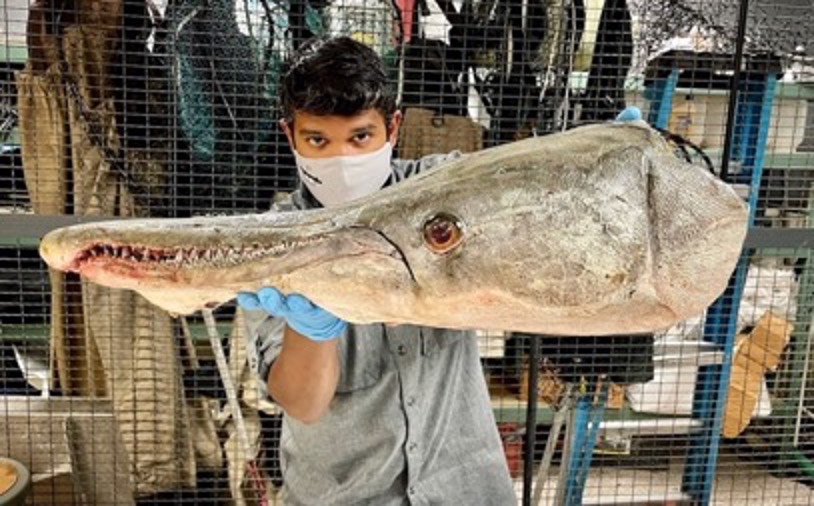
Solomon David is currently an Assistant Professor at Nicholls State University in Thibodaux, Louisiana, where he runs the GarLab and teaches biology, evolution and ecology, and biology of fish. His origin story begins with as a kid reading Ranger Rick magazine. Like many young children, he was fascinated with dinosaurs. When he first read about an Alligator Gar, which coexisted when dinosaurs lived on Earth, he was hooked on gar for life. He claims that “My career, dedicated to prehistoric fish, began with Ranger Rick,” and he is still chasing his childhood fish fascination.
He earned a BS in biology from Ohio Northern University and an MS and PhD from the University of Michigan, where he studied the life history and genetic diversity of Spotted Gar across its range. David also worked as a research associate at Michigan State University on genomics of gar, before he began a joint position as research scientist with the USGS Great Lakes Science Center, and Research Associate at John G. Shedd Aquarium and the University of Wisconsin. At the Shedd Aquarium he had ready access to primitive bony fish on display and contributed to many educational efforts on gars and other primitive bony fish.
Dr. Solomon has published more than thirty publications on a variety of freshwater fish, from gars and Bowfins to bloaters, Lake Whitefish, Northern Pike, and Lake Trout. He is active in international networks for gar research and other freshwater fish and has organized special symposiums dedicated to biology and conservation of gars. In addition, he has written numerous articles targeted at a nonscience audience and has offered training for professionals interested in science communications.
Since reading an article about gars in Ranger Rick magazine as a kid, he has become one of the fish’s most vocal defenders and is quick to oppose any angler’s or bowhunter’s persecution of “trash” fish. Matt Miller’s book, Fishing through the apocalypse, describes how Miller and David fished with drones and large carp heads for gargantuan Alligator Gar in Texas (Miller 2019b). They adopted a strict catch-and-release practice.
Solomon David is a popular teacher. From Rate My Professors, a student writes, “Very passionate about his subject material, which makes classes very interesting! He was always very understanding when I had issues arise.” In what may be the first-ever gar-inspired romance, he met his future wife at the Shedd Aquarium. At the time, she thought the most charismatic and interesting creatures at the aquarium were the belugas, sharks, and penguins. But she was soon swept away by his enthusiasm for the African Lungfish, sturgeon, Arapaima, and, of course, the gars.
Solomon David is a charter member and former president of the Science Communication Section of the American Fisheries Society. He has a large following on Twitter (@SolomonRDavid), where he routinely builds enthusiasm and appreciation for primitive fish and debunks myths surrounding gar and other native fish. His work has influenced many new audiences to take another look at gar as a model for scientific studies or a target for recreational fishing. I must confess that he inspired me to write song lyrics for the parody The Accidental Gar. He is not one to avoid controversies. Those who follow him on social media will learn that he believes fish are better than birds, penguins are overhyped, and fish puns are fintastic.
Key Takeaways
- Sturgeons, paddlefish, gars, and Bowfins are old lineages whose ancestors were present on Earth over 150 million years ago.
- Sturgeons, Alligator Gars, and paddlefish were overexploited and extirpated from parts of their range due to habitat change.
- The gar family (Lepisosteidae) has been around since the Cretaceous Period (~100 million years ago).
- Success of gar recovery depends, in part, on changes in human beliefs, norms, and actions.
- Problems have been overharvest, persecution, and waste.
- Propensity for overfishing due to life history traits, including long life and delayed age of maturity.
- Habitats essential for spawning and early life were highly modified by dams, diversions, and floodplain draining.
- Shift in human values related to treating gars as game fish was a slow process.
This chapter was reviewed by Solomon David.
URLs
The Accidental Gar: https://vimeo.com/229492355
Long Descriptions
Figure 8.6: 1) 10 years, approx 60 in; 2) 25 years, approx 70 in; 3) 35 years, approx 80 in; 4) 50 years, approx 85 in, 5) 65 years, approx 90 in; 6) 80 years, approx 100 in. Jump back to Figure 8.6.
Figure 8.9: Decline in numbers of fish with age with 1,000 at age 1 and 0 at age 80; Fish are reproductively mature at age 12 and trophy size at age 23. Jump back to Figure 8.9.
Figure 8.11: Page from old Missouri Fish and Game News. Article titled, “Raids Waged by Deputies Resulted in Destruction of over 5,000 Gar: large schools dynamited by department- all former records shattered- officials received excellent co-operation from sportsmen”. Jump back to Figure 8.11.
Figure References
Figure 8.1: Phylogenetic tree depicting the accepted relationships between sturgeons and paddlefish, gars, Bowfins, and bony fish. Bowfins and gars are sister groups to all bony fish. Kindred Grey. 2022. CC BY 4.0.
Figure 8.2: Alligator Gar (Atractosteus spatula). Duane Raver. 2012. Public domain. http://www.publicdomainfiles.com/show_file.php?id=13483708812923.
Figure 8.3: Longnose Gar. USFWS Mountain-Prairie. 2019. CC BY 2.0. https://flic.kr/p/2fmqruA.
Figure 8.4: Largest Alligator Gar captured in 2011 weighed 327 pounds. Ricky Flynt—MS DWFP. 2011. Used with permission from Ricky Flynt. CC BY 4.0.
Figure 8.5: Processed otolith (sagittae magnified 12.5X) from the current world record Alligator Gar caught from the Mississippi River Basin in Mississippi on February 14, 2011. Otoliths were obtained by Mississippi Wildlife, Fisheries, and Parks, with age assessment and imaging by Texas Parks and Wildlife Department. Nathan G. Smith, Texas Parks and Wildlife Department. Used with permission from Nathan G. Smith. CC BY 4.0.
Figure 8.6: Growth in length of Alligator Gar in Texas. Kindred Grey. 2022. CC BY 4.0. Data from “Characteristics and Conservation of a Trophy Alligator Gar Population in the Middle Trinity River, Texas,” by Buckmeier et al., 2016. https://seafwa.org/journal/2016/characteristics-and-conservation-trophy-alligator-gar-population-middle-trinity-river.
Figure 8.7: Growth in weight of Alligator Gar in Texas. Kindred Grey. 2022. CC BY 4.0. Data from “Characteristics and Conservation of a Trophy Alligator Gar Population in the Middle Trinity River, Texas,” by Buckmeier et al., 2016. https://seafwa.org/journal/2016/characteristics-and-conservation-trophy-alligator-gar-population-middle-trinity-river.
Figure 8.8: Recruitment of two populations of Alligator Gar in Texas demonstrates variable recruitment. Kindred Grey. 2022. CC BY 4.0. Data from “Reproductive Ecology of Alligator Gar: Identification of Environmental Drivers of Recruitment Success,” by Buckmeier et al., 2017. https://seafwa.org/journal/2017/reproductive-ecology-alligator-gar-identification-environmental-drivers-recruitment.
Figure 8.9: Hypothetical decline in numbers of Alligator Gar with age, beginning with 1,000 individuals at the age of one year. Kindred Grey. 2022. CC BY 4.0.
Figure 8.10: Expected effects of fishing regulations on spawning potential ratio (SPR), with the percentage of spawning fish relative to the unfished state (SPR=100). Kindred Grey. 2022. CC BY 4.0. Data from “Modeling the Responses of Alligator Gar Populations to Harvest under Various Length-Based Regulations: Implications for Conservation and Management,” by Nathan Smith et al., 2018. https://doi.org/10.1002/tafs.10040.
Figure 8.11: Page from Missouri Game and Fish News article published in April 1926. Missouri Game and Fish Dept., Missouri Game and Fish News, 1926. Public domain. https://catalog.hathitrust.org/Record/100804086.
Figure 8.12: Spawning habitat suitable for Alligator Gar in the middle Trinity River, Texas, as related to river flow. Kindred Grey. 2022. CC BY 4.0. Data from “Development of a Flow-Specific Floodplain Inundation Model to Assess Alligator Gar Recruitment Success,” by Robertson et. al., 2018. https://doi.org/10.1002/tafs.10045.
Figure 8.13: Shortnose Gar larva with yolk sac and adhesive organ. Kindred Grey. 2022. CC BY 4.0. Includes a picture used with permission from Konrad Schmidt.
Figure 8.14: Solomon David, PhD, with the head of an Alligator Gar. Used with permission from Solomon David. Photo by Derek Sallman. CC BY 4.0.
Text References
Allen, Y., K. Kimmel, and G. Constant. 2020. Using remote sensing to assess Alligator Gar spawning habitat suitability in the lower Mississippi River. North American Journal of Fisheries Management 40:580–594. DOI: 10.1002/nafm.10433.
Beamesderfer, R. C. P., T. A. Rien, and A. A. Nigro. 1995. Differences in the dynamics and potential production of impounded and unimpounded White Sturgeon populations in the lower Columbia River. Transactions of the American Fisheries Society 124:857–872.
Bennett, D. L., R. A. Ott, and C. C. Bonds. 2015. Surveys of Texas bow anglers, with implications for managing Alligator Gar. Journal of the Southeastern Association of Fish and Wildlife Agencies 2:8–14.
Binion, G. R., D. J. Daugherty, and K. A. Bodine. 2015. Population dynamics of Alligator Gar in Choke Canyon Reservoir, Texas: implications for management. Journal of the Southeastern Association of Fish and Wildlife Agencies 2:57–63.
Blok, A. 2021. Gar-bage fish no more. it’s time to respect gar. Environmental Monitor, January 27. Available at: https://www.fondriest.com/news/gar-bage-fish-no-more-its-time-to-respect-gar.htm.
Boreman, J. 1997. Sensitivity of North American sturgeons and paddlefish to fishing mortality. Environmental Biology of Fishes 48:399-405.
Bruch, R. M. 2007. Management of Lake Sturgeon on the Winnebago System: long term impacts of harvest and regulations on population structure. Journal of Applied Ichthyology 15(4-5):142–152.
Bruch, R. M., T .J. Haxton, and H. Rosenthal. 2016. History of the founding and early years of the North American Sturgeon and Paddlefish Society (NASPS). Journal of Applied Ichthyology 32 (Supplement 1):11–14.
Buckmeier, D. L. 2008. Life history and status of the Alligator Gar Atractosteus spatula, with recommendations for management. Texas Parks and Wildlife Department. Available at: https://tpwd.texas.gov/publications/nonpwdpubs/media/gar_status_073108.pdf.
Buckmeier, D. L., N. G. Smith, D. J. Daugherty, and D. L. Bennett. 2017. Reproductive ecology of Alligator Gar: identification of environmental drivers of recruitment success. Journal of the Southeastern Association of Fish and Wildlife Agencies 4:8–17.
Buckmeier, D. L., N. G. Smith, and K. S. Reeves. 2012. Utility of Alligator Gar age estimates from otoliths, pectoral fin rays, and scales. Transactions of the American Fisheries Society 141:1510–1519.
Buckmeier, D. L., N. G. Smith, J. W. Schlechte, A. M. Ferrara, and K. Kirkland. 2016. Characteristics and conservation of a trophy Alligator Gar population in the middle Trinity River, Texas. Journal of the Southeastern Association of Fish and Wildlife Agencies 3:33–38.
Burr, J. G. 1931 Electricity as a means of garfish and carp control. Transactions of the American Fisheries Society 61(1):174–182.
Butler, S. E., L. M. Einfalt, A. A. Abushweka, and D. H. Wahl. 2018. Ontogenetic shifts in prey selection and foraging behaviour of larval and early juvenile Alligator Gar (Atractosteus spatula). Ecology of Freshwater Fish 28(3):385–395. DOI:10.1111/eff.12461.
Caldwell, E. E. 1913. The gar problem. Transactions of the American Fisheries Society 42:61–64.
Cha, W., and R. T. Melstrom. 2018. Catch-and-release regulations and paddlefish angler preferences. Journal of Environmental Management 214:1–8.
Conover, G., R. Simmonds, and M. Whalen, editors. 2007. Management and control plan for Bighead, Black, Grass, and Silver carps in the United States. Asian Carp Working Group, Aquatic Nuisance Species Task Force, Washington, D. C. Available at: https://invasivecarp.us/Documents/Carps_Management_Plan.pdf. Accessed May 30, 2017.
Daugherty, D. J., A. H. Andrews, and N. G. Smith. 2020. Otolith-based age estimates of Alligator Gar assessed using bomb radiocarbon dating to greater than 60 years. North American Journal of Fisheries Management 40:613–621.
David, S. R. 2016. The 7 wonderful gar of the world. The Fisheries Blog. September 6. Available at: https://thefisheriesblog.com/2016/09/06/the-7-wonderful-gar-of-the-world/.
David, S. R. 2018. Angling for ancient fish. American Scientist Blogs. August 17. Available at: https://www.americanscientist.org/blog/macroscope/angling-for-ancient-fish.
David, S. R., S. M. King, and J. A. Stein. 2018. Introduction to a special section: angling for dinosaurs—status and future study of the ecology, conservation, and management of ancient fishes. Transactions of the American Fisheries Society 147:623–625.
Forbes, S. A., and R. E. Richardson. 1920. Fishes of Illinois, vol. 1, 2nd ed. Illinois Natural History Survey, Springfield.
Frenette, B. D., and R. A. Snow. 2016. Natural habitat conditions in a captive environment lead to spawning of Spotted Gar. Transactions of the American Fisheries Society 145:835–838.
Frimpong, E. A. 2018. A case for conserving common species. PLoS Biology 16:e2004261. https://doi.org/10.1371/journal.pbio.2004261.
Gowanloch, J. N. 1933. Fishes and fishing in Louisiana. Department of Conservation, State of Louisiana, New Orleans.
Gowanloch, J. N. 1940. Control of garfish in Louisiana. Transactions of the North American Wildlife Conference 5:292–295.
Harried B. L., D. J. Daugherty, D. J. Hoeinghaus, A. P. Roberts, B. J. Venables, T. M. Sutton, and B. K. Soulen. 2020. Population contributions of BOFFFFs may be eroded by contaminant body burden and maternal transfer: a case study of Alligator Gar. North American Journal of Fisheries Management 40(3):566–579. DOI: 10.1002/nafm.10382.
Hixon, M. A., D. W. Johnson, and S. M. Sogard. 2014. BOFFFFs: on the importance of conserving old-growth age structure in fishery populations. ICES Journal of Marine Science 71:2171–2185.
Jelks, H. L., S. J. Walsh, N. M. Burkhead, S. Contreras-Balderas, E. Diaz-Pardo, D. A. Hendrickson, L. Lyons, N. E. Mandrak, F. McCormick, J. S. Nelson, S. P. Platania, B. A. Porter, C. B. Renaud, J. J. Schmitter-Soto, E. B. Taylor, and M. L. Warren. 2008. Conservation status of imperiled North American freshwater and diadromous fishes. Fisheries 33(8):372–407.
Jordan, D. S. 1905. A guide to the study of fishes, vol. 2. H. Holt, New York. Available at: https://www.gutenberg.org/files/51702/51702-h/51702-h.htm.
Kikugawa, K., K. Katoh, S. Kuraku, H. Sakurai, O. Ishida, N. Iwabe, and T. Miyata. 2004. Basal jawed vertebrate phylogeny inferred from multiple nuclear DNA-coded genes. BMC Biology 2:3. https://doi.org/10.1186/1741-7007-2-3.
Kimmel, K., Y. Allen, and G. Constant. 2014. Seeing is believing: Alligator Gar spawning event confirms model predictions. Landscape Conservation Cooperative Network, Falls Church, VA. Available at: https://lccnetwork.org/sites/default/files/Blog/Seeing%20is%20Believing-Kimmel.pdf.
Lochmann, S., E. L. Brinkman, and D. A. Hahn. 2021. Movements and macrohabitat use of Alligator Gar in relation to a low head lock and dam system. North American Journal of Fisheries Management 41:204–216.
Long, J. M., R. A. Snow, and M. J. Porta. 2020. Effects of temperature on hatching rate and early development of Alligator Gar and Spotted Gar in a laboratory setting. North American Journal of Fisheries Management 40:661–668.
Mendoza, R., C. Aguilera, and A. M. Ferrara. 2008. Gar biology and culture: status and prospects. Aquaculture Research 39:748–763.
Miller, M. L. 2019a. Afield with the gar professor. Cool Green Science blog. April 29. Available at: https://blog.nature.org/science/2019/04/29/afield-with-the-gar-professor/.
Miller, M. L. 2019b. Fishing through the apocalypse: an angler’s adventures in the 21st century. Lyons Press, Lanham, MD.
Miller, M. L. 2017. Gar wars: a fish force awakens. Cool Green Science blog. November 13. Available at: https://blog.nature.org/science/2017/11/13/gar-wars-a-fish-force-awakens/.
Orth, D. 2015. Such a long nose and such big teeth, it can only be the Longnose Gar. Virginia Tech Ichthyology Class blog. September 11. Available at: https://vtichthyology.blogspot.com/2015/09/such-long-nose-and-such-big-teeth-it.html.
Ostrand, K. G., M. L. Thies, D. D. Hall, and M. Carpenter. 1996. Gar ichthyotoxin: its effect on natural predators and the toxin’s evolutionary function. The Southwestern Naturalist 41:375–377.
Pikitch, E. K. P. Koukakis, L. Lauck, P. Chakrabarty, and D. L. Erickson. 2005. Status, trends and management of sturgeon and paddlefish fisheries. Fish and Fisheries 6:233–265.
Porta, M. J., R. A Snow, and K. G. Graves. 2019. Efficacy of spawning Alligator Gars in recreational-grade swimming pools. North American Journal of Aquaculture 81(2):126–129. https://doi.org/10.1002/naaq.10078.
Reitz, E .J., C. S. Hadden, G. A. Waselkov, and C. F. T. Andrus. 2021. Woodland-period fisheries on the north-central coast of the Gulf of Mexico. Southeastern Archaeology 40:135–155.
Richardson, R. E. 1913. Observations on the breeding habits of fishes at Havana, Illinois, 1910 and 1911. Bulletin of the Illinois State Laboratory of Natural History 9(1-12). Available at: https://www.biodiversitylibrary.org/item/35136#page/471/mode/1up.
Robertson, C. R., K. Aziz, D. L. Buckmeier, and N. G. Smith. 2018. Development of a flow-specific floodplain inundation model to assess Alligator Gar recruitment success. Transactions of the American Fisheries Society 147:674–686.
Rypel, A. L., P. Saffarinia, C. C. Vaughn, L. Nesper, K. O’Reilly, C. A. Parisek, M. L. Miller, P. B. Moyle, and N. A. Fangue. 2021. Goodbye to “rough fish”: paradigm shift in the conservation of native fishes. Fisheries 46(12):605–616.
Sakaris, P. C., D. L. Buckmeier, N. G. Smith, and D. J. Daugherty. 2019. Daily age estimation reveals rapid growth of age-0 Alligator Gar in the wild. Journal of Applied Ichthyology 35(6):1218–1224.
Scarnecchia, D. L. 1992. A reappraisal of gars and Bowfins in fisheries management. Fisheries 17(5):6–12.
Scarnecchia, D. L., and J. D. Schooley. 2020. Bowfishing in the United States: history, status, ecological impact, and a need for management. Transactions of the Kansas Academy of Science 123:285–338.
Schmitt, K. 2015. Gar farming. American Currents 40(4):3–9.
Schumann, D. A., M. E. Colvin, L. E. Miranda, and D. T. Jones-Farrand. 2020. Occurrence and co-occurrence patterns of gar in river–floodplain habitats: leveraging species coexistence to benefit distributional models. North American Journal of Fisheries Management 40:622–637. DOI: 10.1002/nafm.10402.
Sherman, V. R., H. Quan, W. Yang, and M. A. Myers. 2017. A comparative study of piscine defense: the scales of Arapaima gigas, Latimeria chalumnae and Atractosteus spatula. Journal of the Mechanical Behavior of Biomedical Materials 73:1–16. DOI: 10.1016/j.jmbbm.2016.10.001.
Smith, N. G., D. J. Daugherty, E. Brinkman, M. Wegener, B. R. Kreiser, A. Ferrara, K. Kimmel, and S. David. 2020. Advances in conservation and management of the Alligator Gar: a synthesis of current knowledge and introduction to a special section. North American Journal of Fisheries Management 40(3):527–543.
Smith, N. G., D. J. Daugherty, J. W. Schlechte, and D. L. Buckmeier. 2018. Modeling the responses of Alligator Gar populations to harvest under various length-based regulations: implications for conservation and management. Transactions of the American Fisheries Society 147:665–673.
Snow, R. A., M. J. Porta, R. W. Simmons, and J. B. Bartnicki. 2018. Early life history characteristics and contributions of stocked juvenile Alligator Gar in Lake Texoma, Oklahoma. Proceedings of the Oklahoma Academy of Science 98:46–54.
Spitzer, M. 2015. Return of the gar. University of North Texas Press, Denton.
Spitzer, M. 2010. Season of the gar: adventures in pursuit of America’s most misunderstood fish. University of Arkansas Press, Fayetteville.
Tarzwell, C. 1945. The possibilities of a commercial fishery in the TVA impoundments and its value in solving the sport and rough fish problems. Transactions of the American Fisheries Society 73:137–157.
Tompkins, S. 2019. Texas hunters and anglers in for big rule changes. Houston Chronicle, August 14.
Zhang, H., I. Jarić, D. L. Roberts, Y. He, H. Du, J. Wu, C. Wang, and Q. Wei. 2020. Extinction of one of the world’s largest freshwater fishes: lessons for conserving the endangered Yangtze fauna. Science of the Total Environment 710:136242. https://doi.org/10.1016/j.scitotenv.2019.136242.
- View that we can and should carry on our practice of moral deliberation without reference to moral truths ↵
An extinct reptile, specifically a plesiosaur with a short neck, large head, and massive toothed jaws
Any of a large group of pesticides and other synthetic organic compounds with chlorinated aromatic molecules

